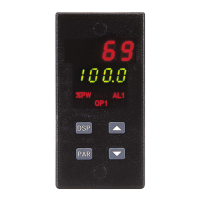Alarm Hysteresis (AHYS)
Thealarm(s)valueshave aprogrammablehysteresisb and toprevent alarm
outputchatter nearthealarmtrigger temperature.Thehysteresis valueshould
be setto eliminatethis effect. A valueof 2° to 5°is usually sufficientf or most
applications. A single alarm hysteresis value applies to both alarms. See the
alarmaction figures, page 29, forthe effect of hysteresis onthe various alarm
types.
AHYS - 1 to 250 degrees
Cooling Output Module (5-02) (Optional)
The optional secondary output (OP2) operates as an independent cooling
output for systems that use heating and cooling. One of the three types of
output modules (Relay, Logic/SSR Drive or Triac) must be ordered
separately and installed into the cooling channel socket. The output modules
may be replaced or interchanged (with appropriate wiring considerations) at
any time without re-programming the controller.
The front panel indicator OP2 illuminates when the cooling output is on.
(See Output Module “OUTPUT ON” State Table, page 6, for definition,
under installing output modules section). Cooling output power is defined as
ranging from-100%(full cooling) to0% (no cooling,unless a heat-coolband
overlap is used).
Cooling Cycle Time (CYC2)
A value of 0 turns off the cooling output, independent of cooling power
demand.
CYC2 - 0 to 250 seconds
Cooling Relative Gain (GAN2)
This parameter defines the g ain o f the cooling band relative to the heating
band. A value of 0.0 places the cooling output into ON/OFF control mode
with theHeat-Cool parameter (db-2)becomingthe cooling outputhysteresis.
This may be done independent of the main output control mode (PID or
ON/OFF). Relative gain is generally set to balance the effects of cooling to
that of heating for best control.
GAN2 - 0 .0 to 10.0
Example: If 10 KW of heating and 5 KW of cooling is available, initially set
the cooling g ain to (2.0). Figure 18, Heat/Cool Operation illustrates the
effect of different gains.
Heat-Cool Overlap/Deadband (db-2)
This parameter def ines the area in which both heating and cooling are
active (negative value) or the deadband area between the bands (positive
value). The parameter units are degrees or tenth’s of degrees (depending on
system resolution). If a heat/cool overlap is specified, the displayed percent
outputpoweris thesumoftheheatpower (OP1)andthecoolpower(OP2).
db-2 - -999 to 9999
If cooling relative gain is zero, the cooling output operates in the ON/OFF
mode, with this parameter becoming the cooling output hysteresis (positive
value only). The Heat/Cool Operation Figures illustrate the effects of
different deadbands.
Figure 18, Heat/Cool Operation (db=0)
Figure 19, Heat/Cool Operation (db>0)

